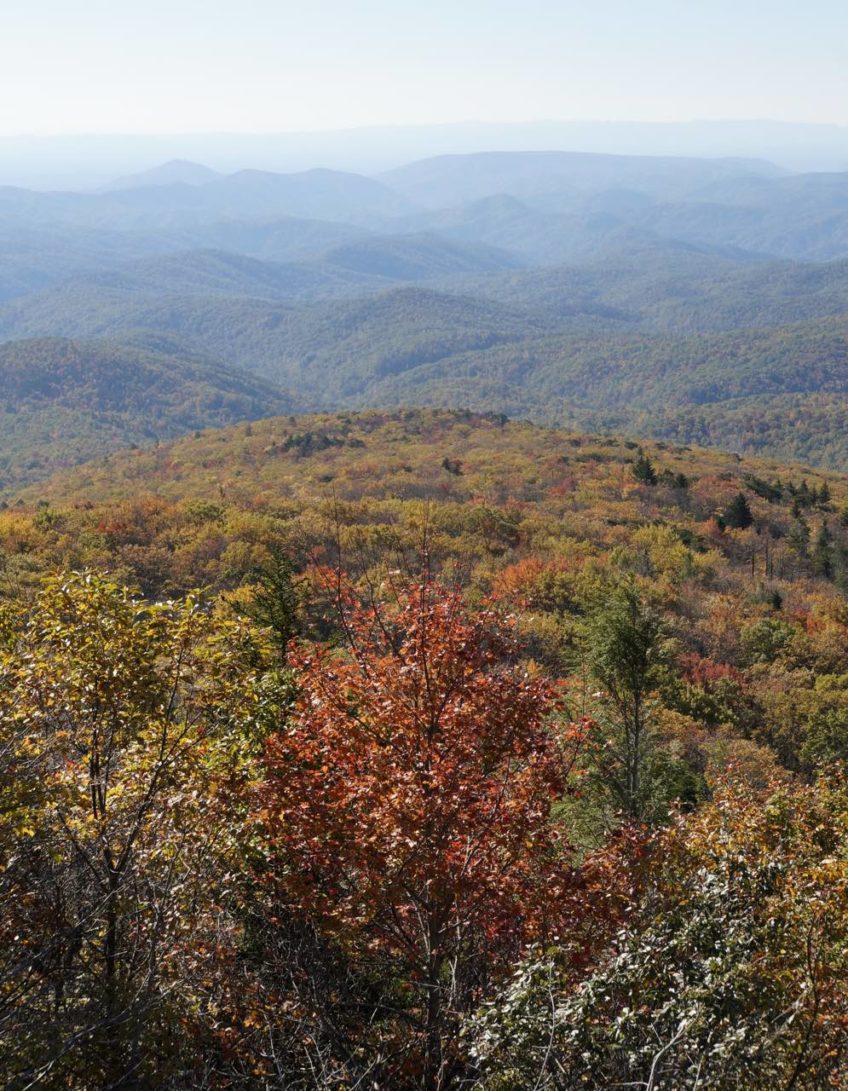Even though I had tasted some of the Blue Ridge Parkway before, I couldn’t help but be excited by the prospect of dedicating a few days to winding along its lofty route. Dotted with countless overlooks and at least a dozen visitor centers, this 469-mile connector between Virginia’s Shenandoah National Park and North Carolina’s (and Tennessee’s) Great Smoky Mountain National Park is one of the crowning achievements of the New Deal. Despite its history as a Depression-Era project, the Parkway was not completed until the Linn Cove Viaduct opened in 1987. It continues to be one of the most popular attractions in the federal park system.

Although the speed limit generally idles along at 45 miles per hour, this “All-American Road” is well worth the extra time it takes. Vibrant fall colors punctuated each winding vista and filtered the sun into fiery beams that ushered me through dozens of tunnels. Despite the beauty of the road itself, it also provides unparalleled access to the trails of the Blue Ridge. Although places like Linville Gorge, Great Smoky Mountains, and Pisgah National Forest have their own trail systems, the Parkway allows for motorists to ease into the landscape, exploring an overlook every now and then, or spending time on one of its many trails. Once you are on the Parkway, unlike on an interstate, life becomes simple. All you have to do is marvel at the world around you… and make sure not to weave into the other lane. The access points are few and the distance between them large, meaning you are on the Parkway to enjoy the Parkway. No one is in a rush, you and your fellow driver’s are simply there to enjoy.

After my short stint on the Blue Ridge the night before, I awoke in Waynesville ready for another day. Once again Sam was sheathed in frost. I had bundled up accordingly before going to bed, so I wasn’t chilled when I woke up. I was, however, slow to relinquish my warm covers. It felt similar to never wanting to leave the safety of your covers on a snow day, except I am a 24-year old sleeping in a car in a Walmart parking lot that has seen its first frost of a season. It felt glorious all the same.

After prying myself out of bed, I jumped back on the Parkway. Knowing that it was now a Saturday, I wanted to get as far as I could before the weekend crew started flooding the trails. My plan worked until 10:00 AM, then the crowds were there to stay. Like the Skyline Drive, the Blue Ridge Parkway acts as the arterial road of the Appalachian Mountains, with hundreds of overlooks and trails pulsing off of it in every direction. As a driver, all you have to do is allow your curiosity to take over and you will find ample opportunities for exploration. I chose Devil’s Courthouse, Craggy Gardens, Mount Mitchell, and Linville Falls as my cross section. Like the day before, the wind was harsh and the weather brisk. Lucky for me, it kept most people in their cars.


After finishing American Gods by Neil Gaiman two days prior, I had switched over to The World Without Us by Alan Weisman. This book is entirely based around a “What if” question, something my teachers always warned me about. His question is “what if humans disappeared overnight, how would the world react? How long would it take for our systems to collapse? How long would it take the planet to recover? Could it recover? Should we think of it as “recovery” or just another era of life on Earth?” It is a big question that spawns many more questions, but he tackles each with excellent examples and engaging prose. Listening to him talk about the ways in which ecosystems would recuperate or how pollutants would continue to harm our world as I drove through under a sunlit canopy of wild reds and vibrant oranges felt… weird. I don’t know how to explain it. Part of me saw the contradiction of the Blue Ridge Parkway. It provides unparalleled automobile access to nature, while automobiles are one of the things that are intrinsically linked to the build up of greenhouse gases in our atmosphere. The other part wondered how “natural” this ecosystem really is. Are these trees native? How is this ecosystem, despite its protected status, fighting to survive in a world populated by humans? Would this ecosystem be better off without us?


Whenever I took a break from the book to explore, I realized that I was slowly beginning to view the Parkway and its motorists as agents of humanities relationship with the Earth. Through that lens, I viewed the world around me as I drove north. From the heights of Devil’s Courthouse, Craggy Gardens, and Mount Mitchell to the depths of Linville Gorge, I saw humans constantly interacting with their environment, often marveling at the world around them. Yet every time I descended from the Parkway, I entered our designed reality of convenient consumption filled with fast food chains, countless gas stations, and cheap accommodations. As a result of the isolation of the Parkway, the transition from a relatively wild landscape to a completely human landscape often progressed over the course of thirty to fifty miles, easing drivers back into their comfort zone. The dichotomy of my nightly departures and morning arrivals onto the Parkway were slightly unnerving.

As I continued north, the terrain grew slightly more gradual, but no less beautiful. Driving over the Linn Cove Viaduct, a diversion into thin air to avoid contact with the fragile ecosystem of Grandfather Mountain, I felt the careful planning and dedication that went into its execution. From underneath, or as a motorist, it feels like you are floating just above the forest. At my last overlook, I pulled up and cooked up a batch of lentils, lingering on the grass as my pressure cooker did most of the work. Then, I descended, away from the Blue Ridge to the northwest, ready for the next stop.



All in all, I drove over 200 miles on the Parkway over the course of three days. When I turned off, headed for Boone, NC, I wondered when I would next experience another road like it. It truly is a marvel of both American wilderness and American ingenuity.
This felt mapworthy…




2 Responses
Jean Cronon
I am glad you packed for all kinds of weather. Freezing temperatures are no fun if you can’t stay warm. Even if you are only 24!
Mom
Great entry, Jeremy. Loved the photos of the underside of the roadway and your cooking set-up!